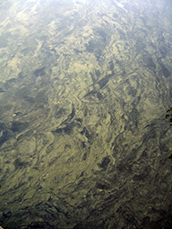Press release 2016-06-02 at 10:22
According to the estimate of the Finnish Environment Institute’s Marine Research Centre, this year the risk of blue-green algal blooms is considerable in a large part of the Gulf of Finland, the Finnish Archipelago Sea and the northern part of the Baltic Sea's main basin. In the central and southern parts of the Bothnian Sea and the eastern Gulf of Finland the risk is moderate. In the northern part of the Bothnian Sea and the Bothnian Bay the risk is low.
Even heavy blue-green algal blooms are possible – weather conditions are critical
The risk of extensive blue-green algal blooms at certain points in our marine areas is considerable. Like the previous winter, the phosphate content in the surface layer of the Gulf of Finland was fairly high in the past winter. In the Gulf of Finland, the phosphates that flowed into deep waters from the main basin and were released from the sea floor due to poor oxygen conditions have mixed in with the higher water layers as a result of winter storms. In addition to the Gulf of Finland, a nutrient situation with a phosphorus content that is relatively high compared to nitrogen has also occurred in the north of the Baltic Sea main basin and the Finnish Archipelago Sea during the winter. It enables quite heavy blue-green algal blooms in the coming summer in these areas, provided that also the weather conditions are favourable.
The bloom period in Finland's sea areas usually peaks in late July and early August. Calm and warm weather promotes the formation of algal blooms. Even though in some areas blooms may continue well into autumn, they will not be as massive as during the summer. In the summer of 2016, the risk of extensive blue-green algal blooms in our marine areas is higher than average compared to recent years, but it is nevertheless clearly lower than during the peak years of the early 2000s, for example.
Basis for the risk assessment
The blue-green algal bloom risk assessment is based on the scenarios created by the Baltic Sea ecosystem model in use at the Finnish Environment Institute SYKE, using the amounts of nitrogen and phosphorus from last winter and their ratio. The model’s initial data are based on nutrient concentrations measured during the monitoring cruises of SYKE and the Swedish Meteorological and Hydrological Institute SMHI carried out by the research vessel Aranda during the winter of 2016. Since it is impossible to reliably predict the weather conditions of the coming summer, the assessments on the development of blue-green algal blooms are based on wind, sea current and temperature conditions over five previous years of observations. In addition, the measured development of nutrient contents according to the results of the Alg@line monitoring carried out by commercial ships during the spring of 2016 was taken into account.
The results of the model have been assessed by experts. The expert assessment considers the uncertainty issues of the model and draws on the experience of former prognoses and accumulated observational data from previous years. The blue-green algal bloom risk assessment best describes the situation in open sea areas.
The blue-green algae situation can change quickly
The migration of algal blooms formed on the open seas to coastal areas is largely dependent on the prevailing winds and sea currents. The blue-green algal bloom on the surface can migrate into the archipelago and our coasts especially with prevailing southern winds. A strong wind mixes the blue-green algal bloom with the surface water, which makes it more difficult to detect. During a calm period, the blue-green algal bloom resurfaces again quickly.

Blue-green algal bloom. © Pirjo Ferin, Image bank of the Environmental Administration
On the coast and in the archipelago, the sea currents and different kinds of nutrient load sources can cause local blue-green algal blooms, especially during a long calm and warm period. In addition, the wind can cause blue-green algae to build up in coastal waters and on the shores. Because blue-green algae may form various toxins and substances that cause skin irritation, heavy algal blooms should always be treated with caution.
The abundance of algal blooms varies
Weather conditions have the greatest effect on algal blooms. The heaviest blooms occur if windy periods alternate with high pressure at a suitable pace during the summer, in which case nutrients coming from the depths feed the growth of blue-green algae and the water temperature rises to a level favourable to the algae. Sea currents cause blue-green algae to build up, which means that areas of “algal porridge” can alternate with clearer areas even at short distances also in the open sea. According to current information, the major Baltic inflow arriving from the North Sea to the Baltic Sea a year and a half ago has not had any significant effect on the risk of blue-green algal blooms in our marine areas, and the effects of the smaller inflows that have arrived later have remained within the southern Baltic Sea. The study of the effects of the Baltic inflows continues on the monitoring cruises of the research vessel Aranda.
Regular bulletins on algal blooms starting
Starting this week and continuing until the end of August, the Marine Research Centre of the Finnish Environment Institute SYKE will provide weekly updates on the algae situation in Finland's open sea areas.
Further information
Risk assessment of algae blooms
Leading Researcher Harri Kuosa, SYKE Marine Research Centre, firstname.lastname@ymparisto.fi, tel. +358 (0)295 251 106
Ecosystem models
Researcher Kim Dahlbo, SYKE Marine Research Centre, firstname.lastname@ymparisto.fi, tel. +358 (0)295 251 096
The state of the Gulf of Finland and the Baltic Sea
Senior Research Scientist Mika Raateoja, SYKE Marine Research Centre, firstname.lastname@ymparisto.fi, tel. +358 (0)50 5355709
Communications
Communications Manager Sirpa Pellinen, SYKE communications, firstname.lastname@ymparisto.fi, +358 (0)295 251 502